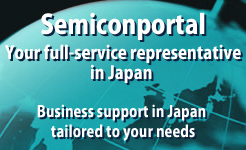Blog: Semiconductor investment recovers all of a sudden—equipment industry booming at last
"What happened? I've never seen such a rush of orders. As semiconductor investment has been in low gear, we can't replenish production facilities and manpower immediately. We are naturally delighted about the tremendous amount of orders, but the deadlines keep us awake at night," said a gleeful executive of a Japanese manufacturer of wafer fab equipment.
This whirlwind was triggered by TSMC's resumption of investment in Fab 14 in Taiwan. TSMC's story has been that back-end-of-line (BEOL) process and double patterning technology for the 20nm generation at the 300mm wafer fab can also be applied to the 16nm generation, implying that major investment is unnecessary.
The volume of orders placed with the equipment manufacturer is off the charts. I think meeting the deadlines will be a struggle for them.
SEMI, the global semiconductor equipment industry association, announced on June 3 that fab equipment spending is in sharp recovery mode. According to SEMI's estimate, investment will surge 24% year on year in 2014 and set a new record in 2015.
Investment in semiconductor production equipment has been flat, running at about US$50 billion annually in recent years. As semiconductor production value hovered around US$300 billion, it was only natural that fab equipment investment did not rise. Even so, since facilities investment is a driver of the semiconductor industry, annual capital investment equivalent to 15% to 20% of production value has been the norm recently.
Following TSMC's resumption of investment, Samsung is expected to show a renewed appetite for aggressive investment too.
As is well known, the Big 3—Intel, Samsung and TSMC—account for around 60% of the US$50 billion that the industry spends on equipment each year. So the investment decisions of this trio of leading chipmakers largely determine the production plans of the equipment and materials industries.
In Japan, too, big investment projects are getting underway. Toshiba, with partner SanDisk, recently announced a new fab construction project representing an investment of 500 billion yen (US$5 billion*). The fab, featuring a 27,300m2 cleanroom, will be equipped with a leading-edge line capable of fabricating 15nm NAND memories. Toshiba intends to complete 3D-structure process technology for fabricating next-generation 3D NAND flash memories. The memories will feature large capacity and high reliability suitable for SSDs and servers for customers with data-intensive operations. That is, Toshiba intends to manufacture flash memory chips targeting infrastructure applications—power plants, distribution centers, telecom base stations and the like, not consumer applications such as smartphones and digital cameras, which have previously been the main driver of the flash memory market.
*Original figures are in Japanese yen. The exchange rate is roughly US$1=100 yen.
Toshiba's archrival in the flash memory space, Samsung, recently started operating a 3D NAND memory fab in Xian, China. Samsung is already offering samples, putting it a step ahead of Toshiba in marketing.
Samsung's 3D line, however, reportedly has some problems. The word on the street is that the yield rate for fabrication of large-capacity, multilayer memory is still low, and so the cost is high. Chasing Samsung, Toshiba is determined to clear the technical hurdles and compete head-to-head with the Korean company in the world market.
Sony is investing 65 billion yen in its semiconductor operations this year, which is fairly modest and almost the same level as last year. 45 billion yen is earmarked for CMOS image sensor production facilities. Sony currently has fabs clustered in Kyushu: the Kumamoto fab is the mother ship while the Kagoshima and Nagasaki fabs play supporting roles. Sony recently acquired Renesas' Yamagata Tsuruoka fab and is refurbishing it. Sony's production capacity will be expanded from 60,000 wafers to 75,000. With 33% of the worldwide CMOS image sensor market, Sony is the dominant player by a wide margin; second-ranked Omnivision has a 16% market share. By investing aggressively, Sony is seeking to increase its share of the CMOS market.
For a long time, the semiconductor equipment industry has been short on animation. In view of the lack of turbocharged growth in the chip market, investment remained slack. So the sudden rush of investment has made equipment manufacturers jump for joy. Even after 30 years of watching the industry, I am still amazed at just what a roller coaster this business is!
Contributed by Wataru Izumiya, President, Sangyo Times, Inc., the publisher of The Semiconductor Industry News.
Translation and links added by SemiconPortal-EmergingTech from Japan
Press release:
SEMI: Strengthening Recovery: Fab Equipment Spending — 24% Increase in 2014, Possible Record in 2015 (June 3, 2014)
Related articles:
May book-to-bill ratio stays below 1, signaling market dip (June 23, 2014)
Toshiba building 3D NAND fab with 500 billion yen investment (May 28, 2014)
Sony transforms Renesas fab into Yamagata Tech for CMOS fabrication (May 21, 2014)
Warning: Invalid argument supplied for foreach() in /home2/semicon/hosting/spiwww/include/Banner.php on line 78
Warning: array_multisort(): Argument #1 is expected to be an array or a sort flag in /home2/semicon/hosting/spiwww/include/Banner.php on line 81
Warning: Invalid argument supplied for foreach() in /home2/semicon/hosting/spiwww/include/Banner.php on line 85



